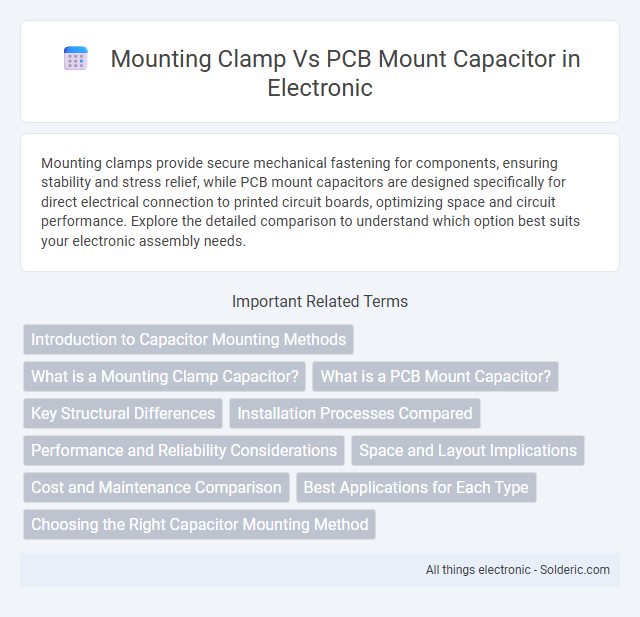Mounting clamps provide secure mechanical fastening for components, ensuring stability and stress relief, while PCB mount capacitors are designed specifically for direct electrical connection to printed circuit boards, optimizing space and circuit performance. Explore the detailed comparison to understand which option best suits your electronic assembly needs.
Comparison Table
| Feature | Mounting Clamp | PCB Mount Capacitor |
|---|---|---|
| Purpose | Secures components or cables mechanically | Stores electrical charge in circuits |
| Application | Used in assemblies, cable management, and mechanical support | Soldered directly onto printed circuit boards (PCBs) |
| Material | Metal or plastic | Ceramic, electrolytic, film, or tantalum |
| Mounting Method | Clamping or snapping onto parts | Surface mount technology (SMT) or through-hole |
| Electrical Role | None (mechanical only) | Active electrical component for filtering, decoupling, timing |
| Size | Varies, generally larger | Compact, designed for PCB footprint |
| Typical Industries | Construction, automation, electrical installations | Electronics manufacturing, telecommunications, automotive |
| Cost | Low to moderate | Varies widely based on capacitance and type |
Introduction to Capacitor Mounting Methods
Capacitor mounting methods significantly impact circuit performance and reliability, with mounting clamps offering easy replacement and robust mechanical support, while PCB mount capacitors provide compact, reliable soldered connections directly on the board. Your choice depends on application requirements such as vibration resistance, space constraints, and thermal management. Carefully selecting between mounting clamps and PCB mount capacitors ensures optimal electrical connectivity and durability in electronic assemblies.
What is a Mounting Clamp Capacitor?
A mounting clamp capacitor is a type of capacitor designed to be secured onto a surface or chassis using a clamp mechanism, providing robust mechanical stability and ease of installation in electrical circuits. Unlike PCB mount capacitors, which are soldered directly onto printed circuit boards, mounting clamp capacitors are ideal for high-power applications or environments prone to vibration and mechanical stress. These capacitors offer reliable performance in industrial equipment, power supplies, and motor control systems due to their enhanced durability and secure mounting features.
What is a PCB Mount Capacitor?
A PCB mount capacitor is a type of capacitor designed specifically for surface mounting directly onto printed circuit boards (PCBs), ensuring compact and reliable electrical connections. Unlike mounting clamps, which are used to secure components mechanically, PCB mount capacitors provide electrical functionality by storing and releasing energy, filtering signals, or decoupling power supply noise. Choosing the right PCB mount capacitor influences the overall performance and stability of Your electronic circuits.
Key Structural Differences
Mounting clamps feature a secure mechanical grip using clamping mechanisms designed to fasten components to a surface, providing easy installation and removal without soldering. PCB mount capacitors have flat terminals or leads designed for direct soldering onto printed circuit boards, ensuring strong electrical connections and compact placement. The primary structural difference lies in the mounting approach: clamps rely on mechanical fastening, while PCB mount capacitors depend on soldered electrical contacts.
Installation Processes Compared
Mounting clamps typically require manual fastening to secure capacitors onto a surface, offering quick and reusable installation ideal for heavy-duty or high-vibration environments. PCB mount capacitors are soldered directly onto circuit board pads, enabling compact, automated assembly and ensuring reliable electrical connections in densely packed electronics. The installation process for mounting clamps involves mechanical tools, while PCB mounting necessitates precision soldering equipment and reflow ovens for mass production.
Performance and Reliability Considerations
Mounting clamps provide enhanced mechanical stability for capacitors in high-vibration environments, reducing the risk of solder joint fatigue compared to PCB mount capacitors which rely primarily on soldered connections. PCB mount capacitors offer compactness and lower parasitic inductance, improving high-frequency performance but may exhibit reduced reliability under thermal cycling stress due to solder joint degradation. Selecting between mounting clamps and PCB mount capacitors depends on the application's mechanical stress tolerance and electrical performance requirements.
Space and Layout Implications
Mounting clamps typically occupy more physical space on a printed circuit board (PCB), which can complicate component placement and reduce overall design density. PCB mount capacitors are designed for compact integration, allowing for streamlined layouts and efficient use of board real estate. Choosing the right option impacts your device's space optimization and thermal management capabilities significantly.
Cost and Maintenance Comparison
Mounting clamp capacitors generally offer lower initial costs compared to PCB mount capacitors, making them a budget-friendly choice for high-power applications. Maintenance for mounting clamp capacitors is typically simpler due to their accessible design, allowing easy replacement and inspection without desoldering. PCB mount capacitors require precise installation with soldering, increasing labor costs and making maintenance more complex and time-consuming.
Best Applications for Each Type
Mounting clamps are ideal for heavy-duty capacitors requiring secure mechanical support in high-vibration environments, commonly seen in industrial equipment and power electronics. PCB mount capacitors excel in compact, low-profile designs where automated assembly and space-saving are critical, such as in consumer electronics and compact circuit boards. Understanding your application's mechanical and electrical demands ensures you select the best capacitor mounting method for optimal performance.
Choosing the Right Capacitor Mounting Method
Choosing the right capacitor mounting method depends on your circuit design requirements, space constraints, and electrical performance. Mounting clamps provide sturdy mechanical support for larger capacitors in high-vibration environments, while PCB mount capacitors offer compact, space-saving solutions ideal for automated assembly and high-density boards. Your selection should balance mechanical stability and signal integrity to optimize overall device reliability and performance.
Mounting clamp vs PCB mount capacitor Infographic

 solderic.com
solderic.com